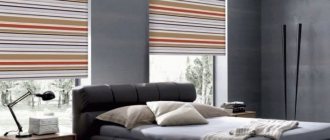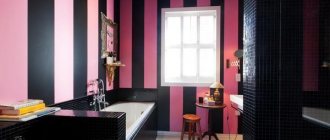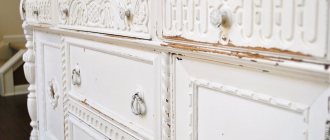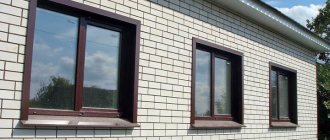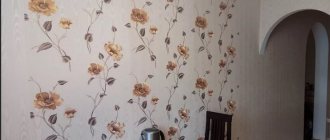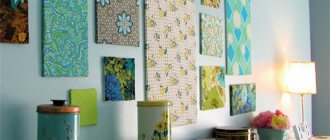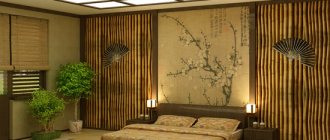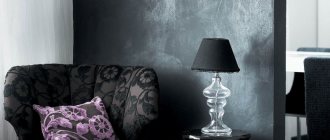Types of paper curtains
Cut-out curtains have a unique design and mechanism. You can choose the style, make them in your own style with the addition of details. Below are popular varieties.
Vertical blinds
Strips of curtains, called slats, are arranged vertically. They rotate at the desired angle and are adjusted with a special rope.
Horizontal blinds
The curtains are characterized by a ladder mechanism. The slats are arranged crosswise. They are raised and lowered by a special drum.
Roller blinds
Blinds that are rolled up using a special mechanism.
Roman curtains made of paper (peacock tail)
Blinds similar to horizontal ones, with a distinctive feature - a rounded fan bottom.
This is interesting: Flower pots: a compact garden in the house (32 photos)
Roman curtains
The main advantage of paper curtains is the ability to make them yourself. For example, Roman blinds are created from wallpaper left over after renovation. The exclusivity of such “curtains” is considered an indisputable advantage. You can rest assured that no one else has curtains like these.
You can choose the color of the paper you like
First, let's decide on the necessary materials and tools:
- Wallpaper. There should be enough of them to cover the windows in one room. Creating Roman blinds from different pieces of wallpaper for one room is not encouraged.
- Sharp scissors. It is thanks to them that there will be no creases on the thick paper.
- Awl for holes.
- Ruler and pencil.
- Decorative cord.
- Stapler, tape, glue.
- Latch. Usually they use a standard clothing option used for sportswear.
Tools and materials for work
Easy way
Let's move on to the process itself. The main thing is to follow the instructions exactly, and then the result is guaranteed to please you.
Scheme for making curtains from wallpaper
First, let's get acquainted with the process of creating classic Roman blinds. We take measurements. As usual, two measurements are required: length and width. It is worth noting that a paper curtain can be placed inside the frame or on top of it; this must be taken into account when measuring the window. We have decided on the width, but the length of the canvas is measured taking into account future folds. To do this, add about a quarter more to the length of the window opening. That is, if the length of the window (glass) was 120 cm, then to form folds you need to add another 30 cm. The total length will be 150 cm. Having cut the canvas of the required size, we make markings for the folds on its reverse side. Using a regular pencil, draw vertical stripes at a distance of 2 or 3 cm.
Cutting the fabric to the required size
Mark the folds with the selected step
Then we get to the fun part. If you haven’t forgotten how to make an “accordion” out of a sheet of paper in elementary school, then the process will not be particularly difficult. To make the folds as even as possible, we make the first one by placing a ruler inside. This will not only make an even fold, but also compress the paper as much as possible.
Carefully fold the accordion, running your fingers along the fold lines
This is the most labor-intensive process. The main thing is not to rush and carefully check each subsequent fold. If you allow the slightest distortion, the entire remaining canvas will turn out crooked. The result should be a non-spring accordion.
It is important that the folds are the same size
At the next stage we make holes for the decorative cord. We retreat 10-15 cm from the edge of the curtain and, using a sharp awl, pierce two holes on each side. In this case, the cord will be placed on the sides of the paper curtain. If you prefer a model with a cord in the center, then two holes are pierced in the middle of the curtain.
We pass the cord through the holes made
It is important that the cord moves freely inside the curtain, but does not dangle. To do this, the holes made with an awl are enlarged using a large nail.
This is what a nearly finished Roman blind looks like
We secure the decorative cord at the bottom with a fastener, and use tape to secure it at the top.
Glue the double-sided tape and hang the curtain on the window
To “unravel” the canvas, we simply loosen the lock. In the case when the decorative cord is located in the middle, when raised, the curtain has the shape of a fan in the lower part.
The hard way
There is also a more complex “recipe” for making Roman blinds from paper with your own hands. To do this, we cut the canvas into separate pieces 10 cm wide. We fold each individual fragment in half and glue it together. The result is something similar to a flattened tube. On each fragment we mark the middle at the top and bottom. Then, following the marks in the central part of the fragments, we glue them together so that the result is an accordion with holes. Leave until the glue dries completely. And then we make holes on the sides, at a distance of 10-15 cm from the edge of the curtain. We pass a decorative cord through the holes and secure it at the bottom with a fastener and at the top with tape. To make the structure more durable, we attach a rail to the top of the curtain.
The result should be a “double” accordion like this:
Using various combinations of paper sheets, you can create very original curtains
An important point: to create paper curtains it is not at all necessary to choose plain wallpaper or boring colors. If such curtains are intended for a children's room or kitchen, bright multi-colored canvases look very organic. They can then be decorated with paper flowers or other decorative elements. And the additional bright details available in the interior will harmoniously complement the picture. In general, don’t be afraid of bright solutions, give free rein to your imagination.
To make pleated curtains or Roman blinds, it is recommended to use wallpaper intended for painting. Firstly, in this way the desired color is created, and secondly, the wallpaper becomes more durable, but at the same time it still transmits light well. And for a similar model of blinds, non-woven wallpaper is more suitable.
What to consider when choosing wallpaper
The main factor when choosing wallpaper is your taste and the expectations you have for the functionality of the curtains. Each material has its own advantages:
- Paper wallpaper will be easy to make. They are lighter and hold their shape well. But they will show through in use, because the material is quite thin. If you don't like too dark rooms, paper curtains are your option;
- Non-woven, vinyl wallpaper is denser. Available in a wide range of colors and patterns. They will not allow light to pass through and will last longer. But they are not very easy to make; you have to hold them so that they do not curl.
When you go to the store for wallpaper, don’t rush to the display cases. Ask sellers about old, unsold wallpaper in stock. They can be purchased in the same quantity for much less.
It is important to consider the size of the window opening. The width of the wallpaper is usually half a meter or a meter. If the window is too large, take meter-long copies; for a small window, wallpaper 50–55 cm wide will be enough.
You can take wallpaper for painting, then you can come up with a design for the curtains yourself. Remember that light colors diffuse light evenly throughout the room. Dark ones will create a feeling of night darkness, safety and comfort.
Do it yourself
From circles
To make paper curtains for windows, you will need paraffin, cardboard, glue, a hole punch or scissors, thread, twine, a small saucepan (bowl) and a paint brush.
- We cut out the cardboard and measure out pieces of wallpaper of the same size. Using a brush, apply heated paraffin to the cardboard sheets, and before it hardens, glue the wallpaper to the cardboard. For a more uniform and reliable fastening, the workpiece should be ironed. It is advisable to do this through fabric. Then we do the same on the back side of the cardboard: apply paraffin, glue the wallpaper, smooth it.
- From the prepared material, cut out circles of arbitrary sizes (from 2 cm in diameter). This can be done using scissors or a hole punch designed for large holes. We string the resulting circles onto curtain threads of the desired length. We distribute the circles evenly along the entire length and fix them with glue. We attach the threads with circles to the common base-cornice.
- You can also use colored paper in combination with wallpaper. Contrasting or, conversely, matching in tone.
Roman
Thick vinyl wallpaper is best suited for this.
- In addition to wallpaper, you will need scissors, a ruler, glue, tape, decorative cord, an awl, buttons or decorative stops.
- We measure the window, add another quarter of the length to the desired length of future curtains (it will disappear in the folds).
- The wallpaper panels should be folded into an accordion (at least 3-4 cm), using pencil markings and making bends using a ruler. Unsightly folds will ruin the appearance of the product.
- It is recommended to glue the first folds to give strength.
- In the folds in the center of the panel we make neat, equally spaced holes through which the cord will pass. To prevent them from losing their shape, we reinforce them with tape.
- We pass a decorative cord through the holes, tying it with a knot at the top; the limiter at the bottom can be an ordinary button or some kind of decorative thing. The lace is brought out to the outside and fixed so that you can easily adjust the height.
- These curtains are secured to the frame with double-sided tape.
- The lower part of the panel is folded in half, and one part is fastened counter to the other, like a fluffy peacock's tail.
Curtain panels
Manufacturing instructions:
- we take wooden blocks with a cross-section of 3x3 cm and a length equal to the dimensions of the window, fasten them with corners and screws;
- cut out even strips from paper or vinyl wallpaper, adding 4 cm to the length of the frame;
- in the upper part of the panel we tighten the screws, leaving them unscrewed by 5-10 mm;
- We fix the cornice on the ceiling, make holes in it corresponding to the size of the screw heads;
- Having secured the screws in the holes, slightly move the panel to the side.
Roller blinds
The advantage of roller blinds is that they fit tightly to the window, providing maximum shading of the room.
When making such curtains, the wallpaper is not folded like an accordion; it is simply rolled into a tight roll. There is no need to make holes for the fixing cords.
- Manufacturing begins with determining the size of the window. The desired length is multiplied by 2 and another ¼ length is added to it for future pockets: the wallpaper will fold in half and acquire density and a double-sided attractive appearance.
- Wallpaper folded in half is glued together using glue or double-sided tape. At the ends the wallpaper is folded into pockets. For this it is better to use a stapler.
- We place weights in the resulting pockets - thin wooden or plastic strips. The tape is attached to the hidden side of the top pocket and runs down both sides.
- We fix the resulting roller blinds in the upper part of the frame, if necessary, open the window, roll up the curtain and grab it on both sides with a tape going down.
If you want to make your home unique, such curtains are the most budget-friendly option for transforming your home. It will take very little time to make them. You can involve children in such creative work and create unique exclusive products together with them.
It should be borne in mind that the folds of paper wallpaper are preserved even when the curtains are lowered: any pattern seems to be refracted. Therefore, you should not use wallpaper with images of people, animals, or fairy-tale creatures. Geometric patterns, marine themes, and floral prints are better suited for this.
Wallpaper curtains are original window decorations; they can be used not only in residential premises, but also on glazed loggias and balconies. Due to high humidity and fumes, paper curtains are not recommended for use in the kitchen. The low cost of the product allows you to change such curtains without any problems depending on the changing interior of your home, the time of year or even your mood.
Solar curtains will add brightness to the feeling, and subdued tones will soothe.
Such a cheap and at the same time original window decoration can be easily changed, allowing you to show inspiration and realize the most unexpected fantasies.
Detailed instructions for creating blinds from wallpaper are in the video below.
Is it possible to make blinds from paper wallpaper?
Paper wallpaper is suitable for making homemade blinds. It is better to take fairly dense fabrics, but other options are also possible.
How do blinds look on wallpaper windows?
DIY window blinds made from pleated wallpaper look playful, covering the entire opening or a separate part of it. The product is attached to the frame using double-sided tape, the bottom in the middle is carefully pulled up, fixed with a hairpin or clothespin so that a fan emerges. You can do without such decorative moves.
DIY blinds look very interesting
The decor on arched windows looks advantageous. To make it, you need to fold the canvas like an accordion and secure it with tape up to 15 mm wide along the edge. Self-made rolls are also available; if you spend time and effort, you will get interesting analogues to bamboo models. The main thing is to think through the opening and closing system.
Important! Blinds as a way to decorate windows and protect from the bright sun came to Russia from the West Indies. In those days, colonial options were in demand.
Types of homemade blinds from wallpaper
Blinds for plastic windows made from wallpaper can be of different types. The most popular versions:
- Vertical type, in which the parts are located in the vertical direction and can be rotated at a given angle. To adjust the rotation of the slats, use a cord
- Horizontal orientation - ladder type models. Here the lamellas are placed in a horizontal position; a “drum” is used for settings
- In the form of rolls - designed as a fabric or paper sheet, which is rolled using a special mechanism into a roll. Roller blinds are a good choice for the living room
- Pleated - canvas folded like an accordion. For regulation, tapes and cords with clamps at the ends are used.
When choosing, be sure to take into account the shape of the windows, ease of adjustment, and material.
Important! Paper wallpaper holds creases well, so they will be a good choice for making homemade blinds.
Methods for decorating windows are chosen to suit your taste.
Advantages and disadvantages
In terms of style, paper blinds are universal, that is, they will be appropriate everywhere. But, given the characteristics of paper sheets, it is better not to use the material in utility rooms and kitchens.
Main advantages of the products:
- ease of creation;
- Sun protection;
- beautiful window decor;
- affordable price;
- the ability to choose any colors and patterns;
- versatility.
You can change these curtains as often as you want; they don’t interfere with the flowers on the windowsill. Disadvantages of decor:
- fragility;
- rapid wear;
- modest appearance (sometimes even called cheap).
Important! Horizontal type models and pleated products are best suited for adjusting room lighting.
Necessary materials
In order to fulfill your fantasy and make paper curtains, first of all you will need paper material. In this case, we are not talking about ordinary paper, but about thicker and brighter paper. As everyone knows, paper products can take on any shape. It is precisely because of this quality of the material that even a housewife inexperienced in needlework can easily make curtains of any complexity and beauty with her own hands.
Horizontal corrugated curtains are the most popular, since the use of such products visually expands the window opening, as well as the space in the room. Also, it is worth noting another important advantage of corrugated paper - it is quite resistant to sunlight. Self-made curtains from such material can retain their original brightness for a long time. Such paper products are sometimes more resistant to ultraviolet radiation than some types of fabric.
If you decide to make curtains for a short service life, you can use the cheapest paper option. Sometimes, you can use ordinary wallpaper as a base, which is often left over after renovation; in this case, you can easily make attractive pleated curtains.
In addition to the basic material, you will need the following elements:
- Wooden planks or small blocks.
- Threads or a fairly strong cord.
- Adhesive substance, as well as a sharp awl.
If you decide to make paper Roman curtains, you will also need cardboard and a small amount of wax.
Accessories for roller blinds
Correctly selected fittings will make the curtain easy to use and create an attractive appearance. As accessories you can choose:
- Cornice. Will act as interior decoration. Such accessories are expensive, suitable for a living room or bedroom. If you have small windows and want to visually expand the space, then choose curtain rods 30-40 cm wider than the window. You can also hang the curtain rod just above the window opening.
- Runners, hooks. Economical, simple option for the kitchen. You will not have any problems with choosing sliders - they are all the same in terms of the method of fastening. All you have to do is decide on the appearance.
- Brackets, chains. The chain mechanism is very easy to use and is popular. Brackets are a durable structure onto which the shaft is mounted. If the blinds are made of thick wallpaper, then it is better to choose long brackets.
- Ropes. The rope mechanism is inexpensive and easy to implement: to do this, sew rings to the side panels and pass threads through them. Attach them to the bottom of the curtain.
- Weights. Serves as a weighting agent. Such a decorative accessory will allow you to emphasize the entire roll structure. All models have different colors, shapes, sizes, and styles, so you can choose the appropriate option for your blinds.
- Additional accessories: handles, decorative strips, other parts.
Types of mechanisms
There are two types of fastening roller blinds: open and closed:
- When the type is open, the cassette shaft on which the web is wound is visible. The shaft is mounted between two holders. This type of mechanism will allow you to fix the curtains above the window opening and in the opening itself. Wallpaper curtains can be controlled using a spring mechanism or a chain. Double-sided tape can serve as a fixation. The disadvantage of this design is that the adhesive layer can melt during the heat. Therefore, it is better to use self-tapping screws or self-tapping screws. The open type of fastening is a budget option that is available to anyone.
- The closed type differs from the first by the presence of a box that masks the cassette shaft, protects it from dust and dirt, and gives the structure a neat appearance. This system is suitable for plastic, wooden and aluminum windows. The system can only be mounted with an inclination of 15°. The closed type of mechanism is more difficult to implement and more expensive than the open type. Installation is carried out by drilling the frame. The control method can be using a chain, a spring mechanism or an electric drive. The latter allows you to adjust the level of illumination remotely using the remote control.
Set of components
In order to install paper curtains with your own hands, you will need the following components:
- plastic or metal box, its guiding element;
- plugs for the box;
- chain, if a manual mechanism is provided;
- connecting elements for the chain;
- brackets;
- a clamp that will fix roller curtains at any distance;
- adhesive tape (double-sided tape), holders, supports for attaching the shaft to the ceiling;
- bracket-clamp, if a spring mechanism is provided.
From wallpaper or paper
Curtains made of paper flowers
Curtains made from paper are an excellent solution for people who need temporary curtains.
They not only protect the room from light exposure, but also look great.
You will need thick paper, the height of which is 25% larger than the window opening.
It is much cheaper and easier to make curtains from any wallpaper that you still have after the renovation.
In this case, the width of the window opening will coincide with their width. As for the tape that will raise the blinds, it is best to choose it in a tone close to the paper.
It requires a cut that is longer than the window. Don't forget about allowances for bows and knots.
If you choose a material without a print (wallpaper with a pattern), then be sure to ensure that the pattern does not warp during cutting and is even. The sheet that you cut out should be folded like an accordion.
The width of each fold should be 3 or 5 cm. Make sure that they all have the same width. If the eye is not so good, then you can make markings with a simple pencil.
Each of the resulting folds must be gathered together to form one strip. The bottom edge on one side is sealed with a not very large piece of paper.
After this, two corners are connected, which are located below and glued to each other with this piece of paper. Next you need to pull the lace with gentle movements through the hole that remains, to the wrong side.
Put on the clamp, with which you can adjust the curtain. If you wish, you can decorate the end of the cord with any decor (bead, bow or tassel). Now the blinds are ready!
Hang them on your window using double-sided tape and enjoy the new decoration of your window.
You can make curtains in other designs. To do this, you need to pull two laces through the curtain. They must run parallel. If you did everything carefully, then in this case it will not be easy to distinguish such a product from the purchased one.
Preparing for work
To make your own curtains from wallpaper, you will need:
- roll of wallpaper;
- ribbons, ropes, laces;
- scissors, stationery knife;
- ruler, measuring tape;
- awl, clamp;
- glue, tape (including double-sided).
Once you have all the necessary tools and materials, you can begin making your blinds.
This is interesting: DIY furniture decoupage (21 photos): the best ideas
Dense material
If you used thick vinyl wallpaper in wall decor, stylish curtains are made from their remains, no worse than the wallpaper curtains in the photo in the magazine.
Related article: Heated floor resistance: how to check the thermostat and sensor
To do this, prepare scissors, a ruler, glue, double-sided tape, thread and an awl.
The work plan is as follows:
- fold the remaining wallpaper sheets into an accordion. To keep them even, use markings with a pencil or make bends with a ruler. Uneven folds will look unsightly;
- Glue the first folds together to give strength;
- if the window is wide and one panel is missing, carefully glue the required number of panels together so that the wallpaper roller blinds cover it completely;
- To make the structure easy to fold and unfold, make special holes in the folds of the wallpaper through which you can pass the cord. To ensure that they are on the same line and do not overtighten the product, use markings. You can use some decorative element or button as a cord stop;
- fasten the curtains to the curtain rod and enjoy the result of your work.
Step-by-step master classes
To create high-quality, neat blinds, follow the instructions step by step, take your time, and be especially careful in your measurements.
The advantage of homemade curtains is the lack of work with drawings.
Each variety has manufacturing features and requires an individual approach. Therefore, decide in advance what kind of curtains you would like to see on the windows.
Accordion blinds
To make blinds from wallpaper with slats bent like an accordion:
- Measure the window in length and width. Add a quarter of the material from the length of the window to the length of your curtains. Otherwise, when folded like an accordion, the curtains will be a quarter shorter.
- Carefully measure the length of the rope according to the length of the curtain.
- Give the piece a pleated look. To do this, measure the strips (it is better if they are from 3 to 5 cm, then the blinds will look elegant and neat.). Make sure that the slats are the same shape. Bend them into an accordion shape.
- If you want to thread the rope along the fabric, use an awl to make a row of holes in the middle of the curtain and insert the lace. You can insert two laces by making holes on the sides.
- Attach the top end of the cord by tying a knot or using tape. If you used two cords, connect them using a clamp, placing a bead at the end or tying a knot.
To make your blinds look three-dimensional, you can increase the width of the slats. This will make the blinds look massive and stylish.
Roller blind
For this option, you will need a tube to secure the curtains. It is best to make blinds from non-woven wallpaper. To make roller blinds, use step-by-step instructions:
- Attach double-sided tape along the entire length of the tube.
- Fix the inside of the curtain to the pipe. Screw the fabric onto the pipe until the very end. Try to roll the wallpaper very tightly.
- Bend the lower end of the fabric by about 5–10 mm, depending on the width of the weight. Insert a weight bar into the resulting groove. Use a weight exactly the width of the blind.
- Insert a mechanism into the pipe to adjust the blinds. Secure the mechanism with a rope or chain at the top of the window. Use double-sided tape or self-tapping screws for this. Or, as shown in the picture, secure the hooks to the top of the curtain by threading the cords through them.
You can learn more about this from the video:
DIY wallpaper blinds\We make roller blinds from wallpaper with our own hands
Fan blinds (peacock tail)
Fan blinds involve steps similar to making accordion blinds. The difference lies in the rounded end of the curtain, reminiscent of a peacock's tail. To make curtains, follow the instructions:
Learn more about this from the master class:
How to make blinds from wallpaper Master class from Angelina Bykova
Blinds made from newspaper tubes
A newspaper is a universal thing in everyday life. Another interesting use for it is making curtains.
To create curtains, follow these steps:
If you do not understand the technology of making curtains from newspaper tubes well, refer to the video MK:
Weaving from newspapers. Blinds. Master Class.
Curtains made from paper clips
To create curtains from paper clips, you can use different threads, leftover wallpaper, magazines, old postcards, and corrugated paper.
This type of curtain looks very original and catchy, due to the sparkling clips. The curtain is considered a good idea for the cottage and garden because of the ease and convenience with which it can be pulled back.
Its production is as follows:
A creative solution would be to secure the threads to some kind of wooden stick. You can use thread instead of paper. To keep the curtain beautiful and sparkling for a long time, you can coat it with glossy varnish.
The author's imagination in this manufacturing option is not limited.
How to make decorative curtains for a doorway with your own hands
Types of decorative curtains
Doorless doorways are not a temporary solution until your next paycheck. Most often, this is a conscious design of the interior with the aim of expanding the room or creating a fuzzy, conditional visual boundary. In this case, curtains are necessary to complete the interior of the room or to place accents.
Curtains can separate:
- corridor from the kitchen;
- kitchen from the hallway;
- living room from the kitchen;
- living room off the corridor;
- zones of one room.
You can make beautiful decorative curtains with your own hands
Manufacturing materials:
- bamboo. Lightweight and durable, do not fade or accumulate static electricity. An environmentally friendly option for soft natural colors for country and oriental style;
- threads Thread curtains can be combined with beads, shells, bugles, and feathers. They look original, but are not durable;
- decorative elements. A type of thread curtains, in the manufacture of which small decorative elements are used: beads, pieces of wood, beads.
- textile. All kinds of options suit different styles.
Types of curtains:
- classic. Fabric, falling from top to bottom;
- French. The folds along the length are dense;
- Japanese. Curtains are similar to screens; the frame can be upholstered with material or fabric;
- bishop's sleeve Tightened in the middle, at the bottom they look like a wide sleeve with a large slouch;
- hourglass. Lightweight fabric gathers in folds in the middle;
- lambrequins. Various configurations with folds and overlaps.
Curtains made of threads with beads
DIY thread curtains
Curtains made of thick threads can be bare or decorated with beads or other decorative elements. To create curtains you will need the following materials and tools:
- various threads made of silk, twine, polyester, viscose;
- decorative elements as desired;
- scissors, tape measure, pencil.
Attention! There are many ways to secure threads. For example, the threads can be intertwined and a bead placed above each knot.
What to do:
- Measure the height and width of the doorway so that the curtain reaches the floor and extends beyond the doorway on the left and right.
- Calculate how many threads are needed, taking into account the distance from one thread to another and the allowance for tying knots at the top.
- Drill the required number of holes in the plank;
- Thread the threads through the holes, tying them with knots.
- Secure decorative elements to them using knots or special fasteners.
- Even if there are no beads along the entire length of the threads, it is advisable to make them at the very bottom. Weighting will help the threads hang vertically.
- Hang the bar over the doorway.
If you do not want to drill holes, you can glue the threads to the bar with a heat gun.
How to make curtains with pendants
For original decoration of the opening, colored pebbles, beads, beads, shells, glass beads, decorative knitted, glass or crystal elements are suitable. Colors can be neutral or, conversely, contrasting, depending on the style of the interior. In addition, you need to prepare:
- beautiful and durable threads;
- braid;
- wooden strip or double-sided tape;
- needle for threading beads.
On average, about 500 threads are needed for a standard doorway.
Curtains made of beads for the doorway
Guide to action:
- Cut the threads to the height of the doorway. You can use the idea with threads of different lengths.
- Cut the tape to a width slightly larger than the doorway.
- Carefully glue the threads along the entire width of the double-sided tape.
- Fold the tape twice so that the threads remain inside.
- Glue tape to the resulting strip in the color of the threads or wall decoration.
- Attach above the doorway.
- Using a needle, string beads onto each thread. It can be secured in different ways: with crepes, pliers, knots or thread threaded twice in different directions.
Advice. If you plan to “paint” a pattern or design with beads, it is better to do this before hanging the curtains. If you just want to put beads on threads, then it is more convenient to do this in a suspended state.
You can weave such beauty, shimmering in the rays of the sun, together with your children. In order to cope with the work, 2-3 days are enough.
Making a Bamboo Curtain
Bamboo curtains are a decoration for an ethnic interior. Previously, they were sold ready-made, with a design. Today, such curtains are more difficult to buy, but they can be created independently. The manufacturing technology will resemble the installation of wooden curtains.
Bamboo curtains can be made from sticks or bamboo beads
You will need:
- sticks made of wood or bamboo;
- fishing line;
- crimps – clips for decoration;
- cornice with rings.
Step-by-step instruction:
- Measure the height of the doorway.
- Cut the fishing line to the required length with a small allowance.
- String the bamboo onto a fishing line, securing each element with crimps at the top and bottom.
- When ready, hang the fishing line on the curtain rings.
- Attach the cornice.
A bamboo or wooden curtain will be denser and stronger than a regular thread curtain.
Sewing an elegant fabric curtain
Fabric is the most common way to decorate a doorway. To make it also unusual, it is better not to purchase standard options, but to do everything yourself. Before work, you need to draw a sketch and take into account the number of frills and lambrequins. Based on this, calculate the required fabric footage. For example, drapery doubles the footage.
Attention! The width of the curtain is calculated by the formula: the width of the cornice multiplied by the gathering factor (from 1.8 to 3x depending on the type of fabric), plus seam allowances.
Source: https://verydveri.ru/handmade/kak-sdelat-dekorativnye-shtory.html
Decoration of finished blinds
The main thing in decorating curtains is a play of imagination, a flight of fancy. You can use various beads, rhinestones, ribbons, colorful pencils and sparkles.
It would be interesting to create a curtain from photo wallpaper and attach it to the outside of the opening. Then there will always be a beautiful view outside your window.
Lace patches and painted flowers will make the blinds elegant and delicate. This design will fit into a room designed in the Rococo style.
It is best to design curtains with the whole family. This activity will bring you together and help develop imagination and creativity. And the blinds will become a memorable exhibit in the museum of comfort.
Paper curtains are easy to make, quick to make, but look beautiful and are inexpensive. They will be an ideal option for those who often move or like variety in the interior.
How to make blinds at home
In order not to be distracted by trips to stores and make mistakes during the manufacturing process, immediately familiarize yourself with the principle of operation. Prepare all the tools in advance. If you doubt you can handle it alone, call for help. Take all the necessary measurements and start creating original roller blinds that will delight you for at least a year.
Tools and materials
Most likely you will find all the materials at home, and you won’t have to go to the store:
- Wallpaper. You can use leftover wallpaper or buy new ones. The wallpaper material is dense, so it is perfect as a sun protection mechanism.
- A meter ruler, a centimeter, a pencil will be needed for measurements.
- Sharp scissors, stationery knife.
- An awl to make holes. You can replace it with another sharp object, such as a hole punch.
- String, rope or decorative tape if you want to decorate your blinds.
- A clamp to secure the blinds. An item of clothing that is often found on the hood cords of a sweatshirt can be used as a fastener. In addition, the retainer can be replaced with a small clothespin that matches the color of the wallpaper or the overall style of the room.
- Double sided tape.
- Glue.
- The drug Concor - instructions for use. Indications for taking Concor for diseases of the heart and blood vessels
- How does diabetes manifest in a child?
- What foods contain protein - table. Products containing protein
Roller blind size
Once you have collected all the necessary equipment, start measuring the window and curtain. Measure the length and width of the glass to which you plan to attach the blinds. The width of the curtain will be the same as that of the window, but the length should be different - additional centimeters are needed to form folds. To do this, add a quarter of this number to the resulting glass length. For example, if the length of the window is 1000 mm, then add another 250 mm - this will be the length of your canvas.
Tools and materials
First of all, you need to make sure you have the necessary tools.
To work you will need:
- Wallpaper that matches the color, you can use the leftovers.
- Sharp scissors. To avoid the appearance of burrs and creases.
- An awl for making holes, which can be replaced with a nail.
- Meter and ruler.
- Pencil. It is not recommended to use a felt-tip pen; it leaves marks.
- Cord. Satin ribbon is suitable as a decorative alternative.
- Scotch tape, glue, stapler.
- Latch. A special element used in clothing to limit drawstrings.
- You may also need a hammer and a block of wood.
Tools and materials needed for making blinds yourself:
Everything you need is prepared in advance; you should use a convenient workplace for the procedure.
On a note! When creating this kind of curtains, you want to get an excellent result that will not be embarrassing to hang on the windows, so many people buy whole rolls of expensive materials. Choosing substandard items or leftovers, which are significantly discounted, will help reduce costs.
Curtain installation options
One of the important points is the installation of curtains. There are several methods for attaching curtains to a window:
- inside the opening. On the top of the window frame, opening, or on the wall above the window itself. To do this, mark the horizon, use fastening materials that are convenient for you;
- outside the opening. Suitable for non-standard windows located shallow in the wall. It will help to darken the room better. Installation may involve special brackets or mounting to the ceiling;
- to the window frame. This method of fastening is especially suitable for plastic windows. Curtains can be attached to the sashes using special fasteners. Opening and closing windows will be much more convenient.
Stacked curtains
To make these curtains with your own hands, you will need the same set of materials as for pleated curtains, plus cardboard and a lot of candle wax or paraffin. The solid mass is melted in a water bath and applied to sheets of thick cardboard using a brush. Immediately apply wallpaper sheets to the prepared base with the pattern facing up - everything needs to be done very quickly, before the paraffin has hardened, so cut out the paper blanks in advance. If the wallpaper does not stick across the entire area at once, it’s not a problem; after gluing, all the elements can be ironed over. The reverse side of the cardboard is lined in the same way.
The resulting blanks are double-sided panels for assembling curtains such as blinds, but you can go further and cut out different figures from them: circles, stars, hearts. After this, we assemble garlands of individual elements with our own hands on threads of the required length. And to improve the light transmittance of the curtains, you can use small separators (beads, pendants or decorative knots) between them. We attach the finished threads to the base, for which we again take strips of a suitable size with holes for fasteners. We tie the garlands on the rail, coat the knots with glue and after it dries, hang the curtain in the kitchen.
Kinds
Wallpaper can become the basis for creating curtains from circles, as well as Roman curtains, roller curtains or blinds.
- Curtains made from circles are more likely to have a decorative purpose than a functional one. They give the room a festive and airy look. They are good for oriental interior style, for use in children's areas.
- Roman blinds are ideal for antique, classic, country and modern styles.
- Roller blinds are more formal and suit absolutely any style.
Types of paper blinds
You can make a wide variety of blinds with your own hands, which will add a unique flavor to your interior. Curtains of a similar design are very popular, but unlike the above, they have two tightening cords. Usually they are placed vertically to each other on opposite sides of the edges.
The only thing to consider is that you need two fasteners and the consumption of the cord and tape will increase. But the product, designed in this form, is identical to real factory blinds. The curtain perfectly covers the windows, protecting the residents of the apartment or house from the sun's rays and prying glances.
Paper roller blinds are extremely popular. They look very impressive, and at the same time completely shade the room, as they fit well to the window. Making a roller blind with your own hands is very easy. Often, when making roller blinds, they take fabric rather than paper. But it’s better to study on paper, since a damaged piece of material will cost the housewife much more than part of a roll of wallpaper.
The peculiarity of making roller blinds is that you don’t need to fold the paper into an accordion - just wind it into a tight small roll. There is no need to make a hole for the tape that will fix the condition of the curtain. The fastening system for this type of paper blinds differs significantly from those already listed.
As a rule, after renovating an apartment, there is always excess wallpaper left over. True, they can be called “superfluous” very conditionally, since there are many options for their use. An example of this is curtains made from wallpaper, the production of which is the subject of this article.
Positive qualities of wallpaper blinds
Before you start making Roman blinds from leftover wallpaper, you should carefully familiarize yourself with the positive qualities of these products. And they have quite a lot of them:
- high degree of availability. Curtains made by yourself will cost less than a finished product, even if expensive material is used for their manufacture. At the same time, their annual replacement will be inexpensive and will save your budget;
- simple production. The process of creating these curtains does not require special skills or extensive experience. Everything is done quickly and easily;
- You can make a beautiful decorative item with an original design with your own hands. On sale there are usually monotonous curtains that do not have an attractive appearance. But when making blinds yourself, you can make original additions and decorative elements;
- For production, you can use wallpaper with a washable structure. This will make caring for the curtain much easier and will also extend its service life.
What tools are needed?
In order to make curtains from wallpaper with your own hands, you need to prepare the following materials for work:
- Paper fabric with a selected design or pattern;
- Cardboard;
- Wax candles. It is worth removing the wick from them in advance;
- Pot;
- Brush;
- Scissors or hole punch;
- Strong threads or twine.
If one or more materials are not available, you can replace them with improvised means. For example, use paraffin candles instead of wax candles.
Instructions
Next, follow the steps below to achieve the desired result:
- lay out the cardboard;
- heat the paraffin and apply it to the sheets with a brush;
- While the paraffin is liquid and the surface is sticky, apply a sheet of wallpaper to the cardboard;
- Apply paraffin again and add another layer of wallpaper;
- Iron the resulting workpiece. Thanks to this, paraffin will reliably hold the paper layers together and be evenly distributed over their surface;
- repeat the same processes on the other side of the cardboard;
- then cut out the circles. This can be done with a hole punch, or the old fashioned way - with scissors;
- string the circles onto the prepared thread, evenly distributing and securing with glue;
- cut the garland of circles into threads, taking into account the dimensions of your window opening;
- Attach the threads to one common base, cornice or pipe so that they have a finished look as curtains.
If you want to make wallpaper curtains for windows more decorative, or choose several colors so that they harmonize well with the rest of the interior, use colored paper.
How Roman blinds are made: device and mechanism
Roman blinds were borrowed from sailors. And today they are made on the principle of sails or blinds: rising and falling pieces of fabric or wallpaper. Curtains are a flat rectangular sheet that covers a window opening. Their feature is a laconic design, harmoniously intertwined with a modern interior. Natural fabrics that are used to make Roman blinds perfectly complement the ethnic style. The obvious advantage of sewing curtains yourself using a master class is the ability to sew them from any non-elastic fabric. The material consumption will be much less than for curtains, so you can use expensive fabric for the pattern. Thanks to tailoring without draperies, the pattern on the blinds comes to the fore.
Roman blinds are distinguished by:
- Type of fastening : in the window opening, on the wall above it, on the window frame. The first two types can be used with homemade cornices, the third - only with factory ones. Most often it is made to order.
- Sewing method - single curtains or double blinds. In the first case, light or translucent fabrics with prints are used, in the second - colored and dense ones that do not fade in the sun. The second option looks neater, but such tailoring requires more effort.
- The method of fastening the rods is tucks, drawstring, special braid. There are models of Roman blinds without rods.
- Type of decoration - finishing with glass beads, cord, fringe, combining fabrics for curtains.
- The mechanism is homemade or factory made.
Roman blinds fit perfectly on windows if they are cut and made exactly to size. To do this, before making Roman blinds with your own hands, you need to prepare the fabric - decate, iron. If the curtain should block sunlight, choose black out fabrics (with special treatment on the reverse side). Translucent fabric will let most of the sun's rays through, covering the window from prying eyes. When choosing a fabric, you need to evaluate it for light: fabrics with complex weaves will look advantageous. If Roman blinds are combined with other types, it must be secured to the glass (inside the window).
The choice of fastening method also determines the fabric consumption:
- The first method (inside the opening) , when the blinds are located near the glass. This option is convenient for large window sills, when they can be used even with the curtains drawn. Or when a curtain is combined with curtains, where it serves as the reverse side.
- The second option (attaching the blinds to the outside of the window) is preferable if it opens completely. The curtain will overlap the slopes by 5-10 cm on each side of the window.
Design of Roman blinds (video)
Types and purpose of pendants
Door hangers serve more of a decorative function than a functional one. Where there is no door or thick curtains, you can fill the opening with curtains of this type. In connected rooms or large living spaces, this is also an original way of zoning.
Today, the most common hanging curtains for doorways are:
- Plastic curtains. Their advantage lies in their affordable price, light weight and variety of design solutions. However, such curtains are not strong and durable.
- Glass curtains. Glass pendants are more expensive and heavier than their plastic counterparts, but they will last longer if they are made of high-quality materials. They also look richer and more sophisticated. It looks beautiful when the beads and various elements of the curtains are asymmetrical and hung in a chaotic manner.
- Bamboo curtains. This model of curtains consists of wooden tubes that are strung on a thread. The tubes can be different in length and color. Bamboo hanging curtains are good because they are made from natural material, are affordable, successfully complement wooden furniture and fit well into almost any interior style. Also, door curtains made of bamboo will protect from the penetration of sunlight.
- Thread curtains. Thread hanging curtains in the doorway are a type of muslin that are hung on windows. Thread curtains consist of narrow strips of fabric, twisted ropes or ribbons. They are often decorated with beads, glass beads, fabric, metallized or plastic accessories.
More and more often in stores you can see hanging curtains made from several materials at once. Plastic beads go well with glass beads. And on thread curtains, shiny multi-colored stones look bright and elegant. With the help of such original combinations you can add charm to any interior. And you don’t need to limit yourself to choosing just one type of curtains.
Tips for choosing
The most durable are wooden pendants. They are easy to care for and do not deteriorate from the sun or temperature changes. The hardest part to attach these curtains to is above the doorway.
It is better to choose plastic curtains for those rooms that are used less frequently than others. In the kitchen or nursery, such curtains will not last long. Of the plastic models for such rooms, only shortened versions of curtains should be used.
Thread curtains are inexpensive, but do not last long. Their main disadvantage is the need for frequent maintenance. It is not enough to simply wipe such curtains with a damp cloth or napkin. They need to be removed regularly and completely washed. In addition, they quickly fade in the sun.
Although pendants are suitable for many spaces, it is necessary to consider the color and design of the model so that it fits well into the interior. For rooms decorated in a modern style, light fabric hanging curtains in soft colors are best suited. Models made from natural fabrics are best used in the living room or bedroom. And for any style of kitchen, models made of artificial material are suitable.
For a room in a rustic style, you should choose wooden hangings or wicker curtains in an antique style. The interior in a classic style will be complemented by curtains made of large beads in pastel colors.
How to make door hangers with your own hands
The easiest way to make pendants for a doorway with your own hands is from threads, beads or seed beads. The choice of material for work depends on the imagination and financial capabilities of the master. In addition, you will need to decide on the design of the model so that it resonates with the overall style of the interior.
To secure the curtain you will need to prepare a cornice. The frame can be made from a metal or wooden stick. Various parts for fastening are not needed, since the threads can simply be tied to the cornice. If you have problems making it yourself, you can purchase a ready-made cornice. Most hangings are attached to a window curtain rod.
Interesting doorway design ideas
Pendants are suitable for decorating any room. But it is especially interesting to choose curtains for a room decorated in an unusual style. Then the decor of the doorway can be supplemented with accessories such as textile insects, metal disks, coins, etc.
Shells and sea pebbles will be a good decoration for pendants in a room with a marine interior. Large multi-colored buttons can be used to decorate the entrance space in a children's room. Tassels on threads create a light atmosphere of romance. And the intricate pattern, when the threads overlap each other, will add mystery to the atmosphere.
Source: https://ODveryah.ru/uluchshenie/visyulki-v-dvernoj-proem
DIY wallpaper curtains - step-by-step instructions
If you decide to decorate your apartment with homemade blinds, then below is a detailed master class on how to make roller blinds from wallpaper:
- Taking window measurements. Carefully calculate the window parameters using a centimeter. When calculating the height of the curtains, do not forget to add a quarter of the total height of the window.
- Preparing and cutting a roll of wallpaper. Clear the table of unnecessary items and lay out the wallpaper. The edges may curl, so place something heavy on them. Mark the required canvas markings.
- Edge processing. To make the curtains last as long as possible, strengthen the edges of the wallpaper with self-adhesive tape or tape.
- Fixation of the upper edge in the roller mechanism. Roller blinds are fixed using tape to the frame of a plastic window. In addition, you can screw in screws or hooks. If you want to fix the blinds to the wall, use screws. At the bottom you can hang special magnets that will prevent the bottom edge from dangling.
- Fastening a cornice with a curtain in a window opening. If the kit includes a cornice, then you need to know a few nuances about its fastening: The distance from the side walls to the cornice may vary depending on the type of structure.
Types of paper curtains
Currently, several variations of wallpaper curtains have been invented. Among them are blinds, Roman blinds, roller blinds and panels.
Paper blinds
Wallpaper blinds are the most common case of decorating the interior of residential apartments, offices and coffee shops. Here are step-by-step instructions for creating blinds.
- Measure the window glass on which the paper curtains will be placed and add 25% to the length of the window. This calculation will allow you to find out how much wallpaper will be needed for finished blinds.
- Take a lace or ribbon along the length of the curtain with an allowance for knots or bows.
- The cut part of the wallpaper needs to be folded like an accordion. In this case, the gap from fold to fold should not exceed 3-5 cm, since wider stripes will not look aesthetically pleasing.
- Also, as in previous cases, you need to make holes using a hole punch or an awl and insert the laces into them. To increase the service life of the blinds, you need to cover with tape on the back side the places where the thread or fishing line will pass to support the curtains.
- You will need to glue double-sided tape to the top step of the blinds, which is attached to the window. It will hold not only the paper web, but also the strings threaded into it.
- If desired, you can also glue double-sided tape to the bottom strip to decorate the edge. A lace ribbon or braid is used to frame the bottom.
- To open and close the blinds, you will need a single-opening latch. As a decoration, you can hang a large bead on the end of the cord.
Any housewife can make such curtains. The main thing is to have a few free hours left.
Roman curtains
Roman blinds are almost identical in design and manufacture to blinds. However, stylistically there are differences. The bottom of Roman curtains made from wallpaper is decorated with a semicircular accordion. This design is called a peacock tail. However, this condition is not necessary for fabric curtains.
The width of the lower folds does not exceed 3-4 cm. It is worth noting that the rope for assembling the curtain is not passed along the sides, as is the case with blinds, but in the center of the canvas.
Paintable wallpaper is perfect for Roman blinds. Their paper is thin and allows light into the room well. This design will look good in the interior of a hallway, kitchen or dining room.
Roller blinds
Roller curtains also have much in common in their design with Roman shades and blinds. However, their distinctive feature lies in the rope mechanism, thanks to which, when lifted, the canvas is wound around the bar.
To make roller curtains you will need two wallpaper sheets of the same size, 2 laces, slats, a furniture stapler, a wooden cornice and ribbons for garters. Making roller blinds is a little more complicated than in previous cases.
First you need to sew or glue the wallpaper so that you get a bag. Next, the wallpaper is turned out and the joints are folded. The sinker is placed in the cut, which is then taped or sutured. The upper part of the curtain and garter is fixed to the wooden cornice using a stapler.
Curtain panels
This type of curtain will require wooden frames. Typically, bars with a cross-section of 3x3 cm are taken. Metal corners and screws are used to connect them. The frame dimensions are determined independently depending on the window parameters.
Wallpaper paper is cut into strips, which are attached to the frames at intervals of 3-4 cm. Self-tapping screws are screwed into the panel at the top. Here you should pay attention to the fact that they do not need to be completed by about 5 cm. Next, a cornice with drilled holes is attached to the ceiling at equidistant distances corresponding to the spaces between the screws. Thus, the screws hold the entire structure on the window.
DIY options
Homemade blinds can be made in a variety of ways, each producing a slightly different result.
Classic way
Work is performed on a free, flat surface. This is necessary in order to avoid distortions while unwinding the rolls and performing the necessary actions.
Video: Master class on making blinds from wallpaper with your own hands
Making blinds from wallpaper looks like this:
The result is a rather original interior element, on which a minimum of time and money is spent.
More complicated way
There is another option where it will take more time, but the result will be more attractive.
Step-by-step making of blinds from wallpaper with your own hands:
- Preliminary marking of the window frame is carried out.
- Strips 10 cm wide are cut. All parts must be smooth, without distortions.
- The fragments made in this way are folded in half and glued along the cut edges. That is, you should get a flattened tube.
- Next is the most difficult moment: each part has a center line at the top and bottom. Thus, the strip is divided into two parts.
- Glue is applied to this line, and the next fragment is glued on top. Each part is glued in the center to the other, you should get an “accordion” with holes.
- After connecting all the elements, the product is left until completely dry.
- Stepping back 100–150 mm from the edge, holes are punched and cords are passed through, which are secured at the bottom with a clamp and at the top with tape.
- To strengthen the structure, you can use a thin wooden strip, to which the upper edge of the wallpaper is glued, and a rope is passed through the holes made and rings are tied.
The operating principle of the curtain is the same as in the previous version.
Curtains made of buoys and foam plastic
There is probably no fisherman who does not have buoys. And polystyrene foam is easy to find in every home, simply taking it from the box of a TV or other household appliance.
In our case, this type of material is perfect for making curtains for doorways. The manufacturing technology is similar to the previous ones.
The only difference is that instead of fishing line or nylon thread, a strong clothesline is used.
Next, the foam with buoys is strung alternately onto each cut piece of rope. Don't forget to secure each piece with knots, just like in the previous cases!
This type of curtain will look harmonious at the entrance, interior opening in a country house or even at home, as well as in a gazebo.
How to make curtains for a gazebo with your own hands - in the video:
